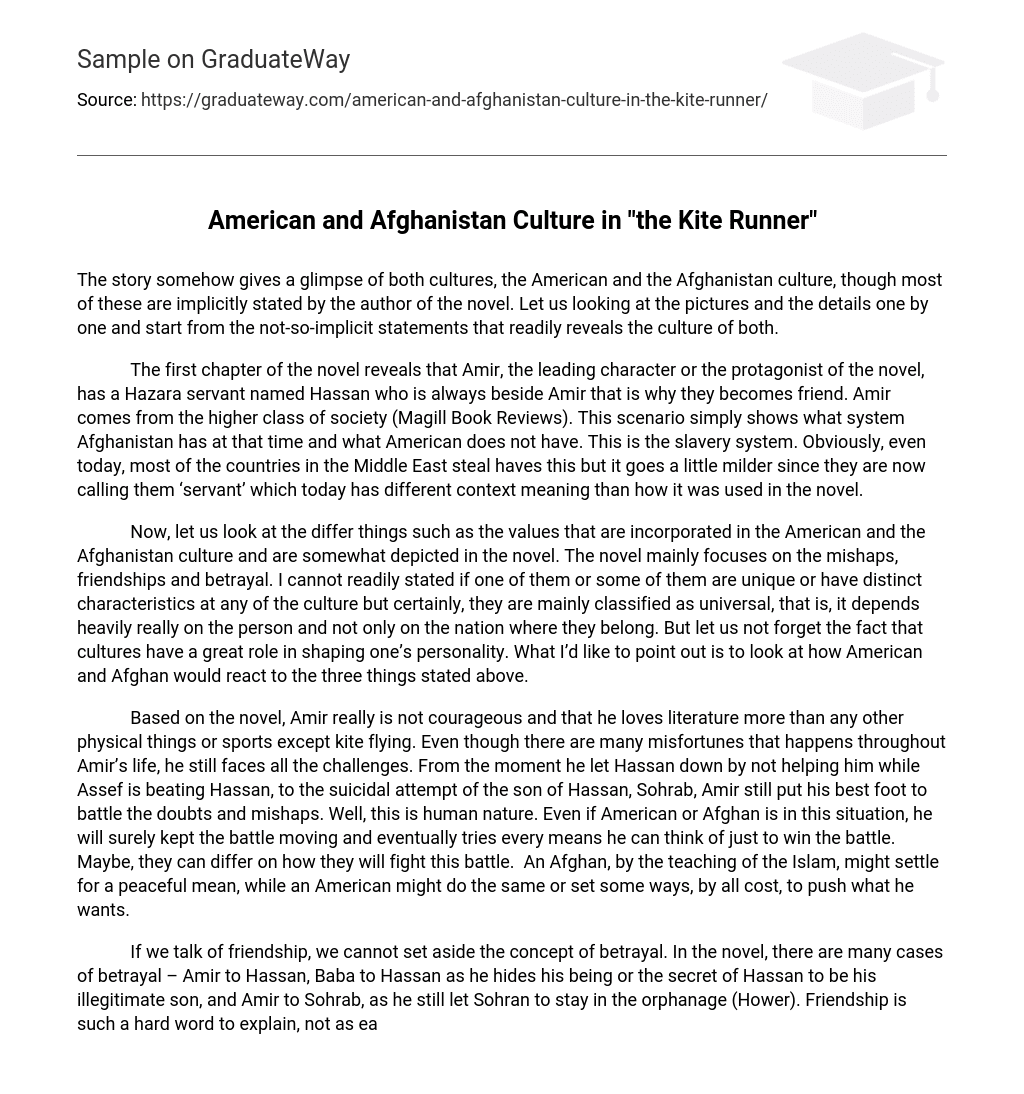The story provides a glimpse of both American and Afghan cultures, although most of these are implicitly stated by the author of the novel. Let us examine the pictures and details one by one, starting with the not-so-implicit statements that readily reveal both cultures.
The first chapter of the novel reveals that Amir, the protagonist, has a Hazara servant named Hassan who is always by his side, leading to their friendship. Amir comes from a higher class in society (Magill Book Reviews), highlighting the presence of a slavery system in Afghanistan at that time. This system is still present in most Middle Eastern countries today but with milder terms such as servant,” which now has a different context than how it was used in the novel.
Now, let us look at the different things incorporated in American and Afghan culture that are somewhat depicted in the novel. The novel mainly focuses on mishaps, friendships, and betrayal. I cannot readily state if one or some of these aspects are unique or have distinct characteristics in either culture, but they are generally classified as universal. It heavily depends on the individual rather than solely on their nationality. However, it is important to note that cultures play a significant role in shaping one’s personality. What I would like to point out is how Americans and Afghans would react to these three themes.
Based on the novel, it is clear that Amir lacks courage and loves literature more than any other physical activity or sport, except for kite flying. Despite the many misfortunes that occur throughout his life, he still faces all the challenges head-on. From the moment he let Hassan down by not helping him while Assef was beating him to the suicidal attempt of Hassan’s son Sohrab, Amir put forth his best effort to battle doubts and mishaps. This is simply human nature; whether one is American or Afghan in this situation, they will surely keep fighting and try every means possible to win. The difference may lie in how they choose to fight this battle. An Afghan might settle for a peaceful solution based on Islamic teachings while an American might do the same or resort to any means necessary to achieve their goal.
If we talk about friendship, we cannot ignore the concept of betrayal. The novel portrays many cases of betrayal, such as Amir’s betrayal of Hassan, Baba’s betrayal of Hassan by hiding his true identity or the secret that he is his illegitimate son, and Amir’s betrayal of Sohrab by leaving him at the orphanage (Hower). Friendship is a complex term to define and understand, unlike the straightforward definition of betrayal. The reason for Amir and Hassan’s friendship was their shared experiences. However, at some point in the novel, Amir left Hassan behind implicitly. If we compare this scenario with how American and Afghan cultures view friendship and loyalty, it can be challenging to reconcile them. Nevertheless, it is essential to note that friendship and loyalty are personality traits rather than cultural ones.
Both cultures value friendship highly but despise betrayal equally. They have similar criteria for what constitutes a friend. However, there may be differences in how they treat their friends or deal with betrayals based on cultural norms. As depicted in the novel The Kite Runner, these differences are not significant.
Truly, comparing cultures is not an easy task. One major reason for this is that the differences in culture are only apparent when Amir goes to the United States and experiences a simpler way of life. As a result, it cannot be explained from an individual’s point of view since the same person experienced both cultures. Overall, the novel focuses on general traits rather than individual experiences and is enjoyable to read.
References
Magill Book Reviews: The Kite Runner (13 July 2007). Retrieved from http://www.enotes.com/salem-lit/kite-runner.
Hower, Edward. The Servant.” The New York Times, 3 Aug. 2003, http://query.nytimes.com/gst/fullpage.html?res=9504E0DF123FF930A3575BC0A9965C8B63. Accessed 13 July 2007.





